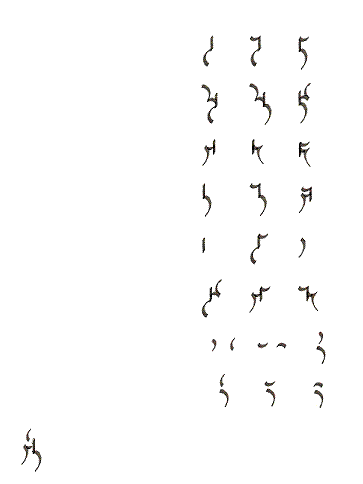User:Masako/sandbox
From FrathWiki
Jump to navigationJump to search
| Subject \ Object | 1SG | 2SG | 3SG | 1PL | 2PL | 3PL |
| 1SG | na'i | na'eta | na'eha | X | na'etam | na'ekam |
| 2SG | ta'ena | ta'i | ta'eha | ta'enam | X | ta'ekam |
| 3SG | ha'ena | ha'eta | ha'i | ha'enam | ha'etam | ha'ekam |
| 1PL | X | nameta | nameha | nami | nametam | namekam |
| 2PL | tamena | X | tameha | tamenam | tami | tamekam |
| 3PL | kamena | kameta | kameha | kamenam | kametam | kami |
| 1st sing | 2nd sing | 3rd sing | 1st plu | 2nd plu | 3rd plu | |
|---|---|---|---|---|---|---|
| 1st sing | na'eta | na'eha | na'etam | na'ekam | ||
| 2nd sing | ta'ena | ta'eha | ta'enam | ta'ekam | ||
| 3rd sing | ha'ena | ha'eta | ha'enam | ha'etam | ha'ekam | |
| 1st plu | nameta | nameha | nametam | namekam | ||
| 2nd plu | tamena | tameha | tamenam | tamekam | ||
| 3rd plu | kamena | kameta | kameha | kamenam | kametam |
y
Kito is an abugida, or syllabic alphabet, used to represent the Kala language.
notable features
- Kito is written in glyph blocks by vertically stacking the syllable glyphs to form words. The script is written vertically, in columns running from left to right.
- The word kito not only refers to the script but also means "mark, symbol, glyph" in Kala.
- Kito was inspired by Phags-pa, and the Chinese Seal Script.
- Kito contains 14 syllable glyphs, 4 cluster glyphs, and 7 vowel diacritics.
consonants
cluster glyphs
vowel diacritics
notes
- The vowels are placed below the syllable they modify.
- The labialisation and palatalization are shown by modifying the vowel diacritics as shown above.
- The script can also be written horizontally in glyph blocks, but this is only done to save space.
pronouns
| Personal | Possessive | Reflexive | Reciprocal | |
|---|---|---|---|---|
| 1st sing | na | nayo | na'i | |
| 2nd sing | ta | tayo | ta'i | |
| 3rd sing | ha | hayo | ha'i | |
| 1st plu | nam | namyo | nami | nanku |
| 2nd plu | tam | tamyo | tami | tanku |
| 3rd plu | kam | kamyo | kami | kanku |
ihato
| interrogative | demonstrative | quantifier | |||||||
|---|---|---|---|---|---|---|---|---|---|
| proximal | distal | existential | elective | universal | negative | alternative | |||
| determiner | which what |
this (sg.) these (pl.) |
that (sg.) those (pl.) |
some | any whichever whichsoever |
every each all |
no | another | |
| pronoun | human | who whom |
this (one) (sg.) these (ones) (pl.) |
that (one) (sg.) those (ones) (pl.) |
someone somebody |
anyone anybody whoever whomever whosoever whomsoever |
everyone everybody all |
no one nobody |
another someone else somebody else |
| nonhuman | what | this (one) (sg.) these (ones) (pl.) |
that (one) (sg.) those (ones) (pl.) |
something | anything whatever whatsoever |
everything all |
nothing | ||
| out of two | which | this one (sg.) these (ones) (pl.) |
that one (sg.) those (ones) (pl.) |
one | either whichever whichsoever |
both | neither | ||
| out of many | some one |
any whichever whichsoever |
each all |
none | |||||
| pro-adverb | location | where | here | there | somewhere | anywhere wherever wheresoever |
everywhere | nowhere | elsewhere |
| source | whence wherefrom |
hence | thence thencefrom |
whenceever whencesoever |
nowhence | ||||
| goal | whither whereto whereinto whereunto |
hither | thither | somewhither | anywhither whithersoever |
nowhither | |||
| time | when | now | then | sometime | anytime whenever whensoever |
always everywhen |
never | ||
| manner | how whereby |
thus hereby |
thereby | somehow | anyhow however howsoever |
noway noways nowise nohow (col.) |
|||
| reason | why wherefore |
therefore | |||||||
